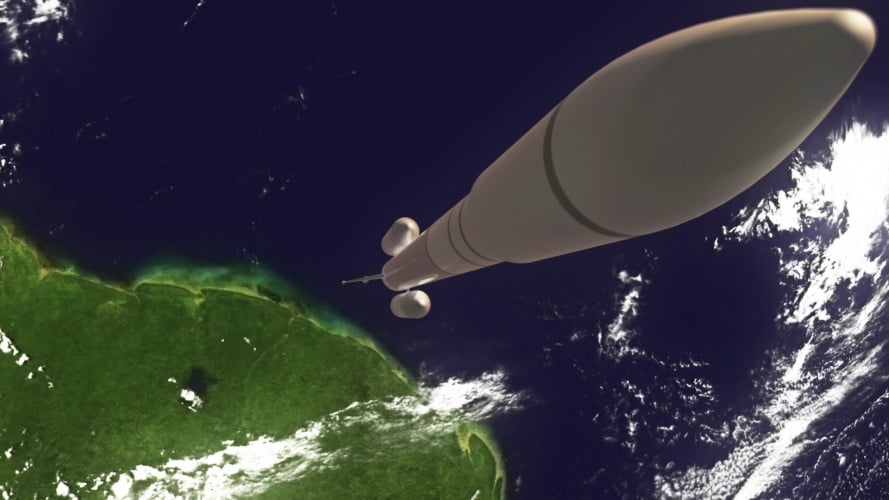
Airbus Space and Defence has been carrying out preliminary tests of a partly reusable space launcher system, which could return the main engines and avionics of potentially any launcher to Earth. Unlike other reusable systems, Adeline (ADvanced Expendable Launcher with INnovative engine Economy) seeks only to reuse thew most costly parts of a launcher system, sacrificing the fuel tanks. It will be compatible with the next version of Europe’s workhorse launcher system, Ariane 6. The company is also planning a reusable ‘space tug’ system that would remain parked in a low Earth orbit to pick up satellites and boost them into their higher orbits before returning to its parked position. Both systems are aimed at reducing the cost of launches.
Adeline is the lower section of the launch vehicle. Equipped with a pair of short wings, it contains the vehicle’s propulsion systems and avionics, protected by a heat shield. It also contains wing-mounted aero engines with deployable propellors protected by detachable fairings. Following the launch and staging of the main launch vehicle, the bottom part would detach, re-enter the atmosphere, pull up using its wings and then deploy its aero engines to fly in as a UAV and land on a conventional runway.
Airbus has been working on Adeline since 2010 and believes it could help it compete against other reusable launcher concepts, such as the Falcon 9 system currently being developed by Space X; so far, Falcon 9 has not made a successful return to Earth. United Launch Alliance (ULA), which is developing NASA’s new Vulcan launch system, is planning a reuse technology where the rocket engines renter the atmosphere and are caught in-flight by a helicopter. Adeline has so far only been tested in a two small-scale flight models designed to test out its overall configuration and atmospheric flight and landing functions.
In use, Adeline would allow 70-80 per cent of the cost of a launch vehicle to be recovered, with its systems being able to fly a projected 8-10 times. It uses heat shield technology developed by Airbus (in its former incarnation as EADS Astrium) for the Mars Express and Huygens Titan probe missions, as well as for French M51 nuclear ICBM weapons. It is expected to be ready for flight by 2025, with Ariane 6 initially flying without any recoverable components with a maiden flight scheduled in 2020.
“The current design for Ariane 6 is fixed. For its maiden flight in 2020, it will not change,” said Francois Auque, the head of space systems at Airbus Defence and Space. “But it is absolutely normal that in parallel we begin to think about what will be the evolution of Ariane 6, because if we don’t already pave the way for those evolutions we will not be in a position to implement them somewhere between 2025 and 2030.”
The upper stage project would see a electrical propulsion ‘space tug’ left in a parking orbit. A launcher’s upper stage would rendezvous with it, hand over its satellite payload and refuel it, then be de-orbited. The tug would put the payload into a transfer orbit using an ion drive system derived from the system developed for the GOCE gravity-measuring satellite mission, or take it to its final working position, for example in a geosynchronous orbit, then return to its parking place for the next mission. At the end of its lifetime, it could be sent on a remote exploration mission or just deorbited.
This technology would mean that launch vehicles could be smaller and use less fuel (a valuable consideration because all of the fuel for a mission has to be sent out of the atmosphere). The satellites themselves would not need to carry fuel, giving more space for operational payload. It could also be used as part of a mission to repair or upgrade satellites, extending their lifetimes; and it would reduce the amount or orbital debris associated with satellite missions.





Poll: Should the UK’s railways be renationalised?
Rail passenger numbers declined from 1.27 million in 1946 to 735,000 in 1994 a fall of 42% over 49 years. In 2019 the last pre-Covid year the number...